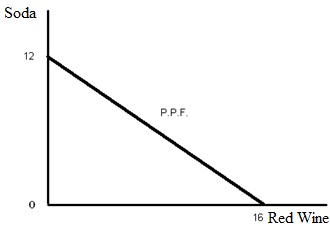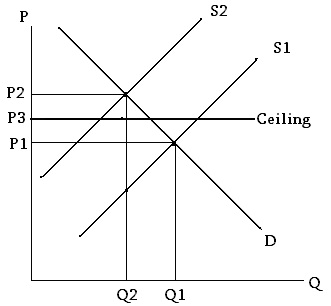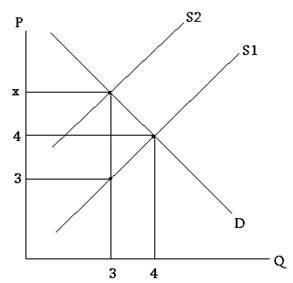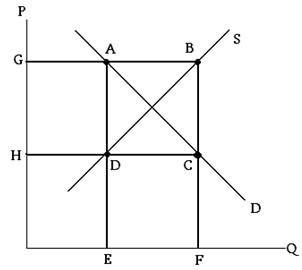Problem 1) Bob consumes two goods, x and y. With which of the following can we infer that good x is inferior?
a. Bob’s demand for good x rises as the price of good y falls
b. Bob’s demand for good y falls as his income rises
c. Bob’s demand for both goods rises as his income rises
d. Bob’s demand for good x falls as his income falls
e. Bob’s demand for good x falls as his income rises
Problem 2) A government-imposed maximum price at which a good can be sold is called a price ______
a. floor.
b. ceiling.
c. support.
d. maximum.
e. minimum.
Problem 3) Which of the following is a positive statement?
a. Elasticity is a measure of the responsiveness of quantity demanded to one of its determinants.
b. Government is not good for the economy.
c. People must think at the margin.
d. Society prefers inflation to unemployment.
e. People should try to avoid trade offs.
Problem 4) If you are studying Microeconomics, then you are interested in:
a. The growth in GDP from 2002 to 2003.
b. How firms price goods in particular markets.
c. The study of economy-wide phenomena, including inflation and unemployment.
d. How exchange rates affect trade.
e. How saving affects growth.
Problem 5) All of the following explain how macroeconomics differs from microeconomics except:
a. Macro is concerned more with aggregate figures.
b. Macro provides a broader view of economic activity.
c. Micro is more concerned with optimal decisions by consumers.
d. Micro studies firms, markets, and pricing decisions.
e. Micro provides figures for the CPI and GDP.
Problem 6) The demand for a good increases when the price of a substitute ____ and also increases when the price of a complement ____.
a. rises; rises
b. rises; falls
c. falls; rises
d. falls; falls
e. all of above are possible
Here are two points on the P.P.F. of Dane County. (Assume Dane County produces only books and brats.)
Books Brats
Pair 1 1,500 0
Pair 2 0 3,000
Problem 7) Assume that the P.P.F. is straight line. What is the opportunity cost of brats in terms of books?
a. 1,500
b. 3,000
c. 1/3,000
d. 1/2
e. 2
Problem 8) Which of the following would usually be consistent with the Law of Supply if everything else were held constant?
a. An increase in the price of a good increases the quantity demanded.
b. An increase in the price of a good decreases the quantity demanded.
c. A decrease in the price of a good increases the quantity supplied.
d. An increase in the price of a good decreases the quantity supplied.
e. An increase in the price of a good increases the quantity supplied.
Problem 9) Consider a market for widgets. The equilibrium quantity of widgets is 150 and equilibrium price is $5. The government imposes a tax of $2 on widgets and raises $200 as revenue. The equilibrium number of widgets has fallen by
a. 30 per month
b. 25 per month
c. 35 per month
d. 20 per month
e. 50 per month
Problem 10) If demand shifts rightward and supply shifts leftward, then equilibrium
a. Quantity demanded goes up and so does price.
b. Quantity demanded goes down and price goes up.
c. Quantity demanded changes in an indeterminate way and price goes down.
d. Quantity demanded changes in an indeterminate way and price goes up.
e. Quantity demanded goes up and price changes in an unknown way.
Problem 11) Consider the following PPF for a beverage factory. Which of the points of production is efficient?

a. 16 red wine, 5 soda
b. 2 red wine, 12 soda
c. 8 red wine, 5 soda
d. 12 red wine, 3 soda
e. 12 red wine, 4 soda
Please use the following figures to answer the next two questions.
Each graph shows the demand of diet vanilla Coke by Cory, Sack and Molly.

Problem 12) According to the figures, we can say that:
a. Sack’s demand is more elastic than Cory and Molly’s demand.
b. Sack’s demand is more inelastic than Cory’s demand.
c. Molly’s demand is more inelastic than Cory’s demand.
d. Sack has a perfectly inelastic demand.
e. Molly’s demand is perfectly inelastic.
Problem 13) Regarding Cory’s demand, if market price falls while it is in the range A of the demand curve we can expect total revenue to___________, while if the market price falls from point B on the demand curve we can expect total revenue to__________.
a. Increase; stay the same.
b. Decrease; increase.
c. Stay the same; increase.
d. Decrease; stay the same.
e. Increase; decrease
Consider the following table for the following three problems. Assume the PPF’s for Ben and Sol are linear.
Time to produce 1 dozen
Apple pies Cream puffs
Ben 4 hrs 2 hrs
Sol 2 hrs 5 hrs
Problem 14) How many apple pies or cream puffs can be produced in 20 hours by Ben?
a. 80 dozen apple pies or 40 dozen cream puffs.
b. 40 dozen apple pies or 80 dozen cream puffs.
c. 5 dozen apple pies or 10 dozen cream puffs.
d. 10 dozen apple pies or 5 dozen cream puffs.
e. 10 dozen apple pies or 4 dozen cream puffs.
Problem 15) What is the opportunity cost of producing 1 dozen cream puffs for Sol?
a. 2/5 dozen apple pies.
b. 5/2 dozen apple pies.
c. 2 dozen apple pies.
d. 1/2 dozen apple pies.
e. 4/10 dozen apple pies.
Problem 16) Which of the following is true?
a. Ben has the comparative advantage in the production of apple pies and absolute advantage in the production of cream puffs.
b. Sol has the comparative advantage in the production of apple pies and absolute advantage in the production of cream puffs.
c. Sol has the absolute and the comparative advantage in the production of apple pies.
d. Ben has the comparative advantage in the production of apple pies.
e. Ben has the absolute and the comparative advantage in the production of apple pies.
For the next question consider the following table.
Price $ Demand Supply
10 20 5
20 10 10
Problem 17) Using the information in the table above, what is the equation of the supply curve (assume it is linear)?
a. Qs = 7.5 + 0.5P
b. Qs = 0.5P
c. Qs = 2P
d. Qs = 10 + 2P
e. Qs = 10 + 0.5P
Problem 18) Suppose the demand curve of a good is horizontal (perfectly elastic) and the supply curve is upward sloping. If a tax is imposed on the suppliers of the good, the economic burden of the tax will fall
a. completely on the seller
b. half on the buyer and half on the seller
c. 1/3 on the buyer and 1/3 on the seller
d. completely on the buyer
e. 1/3 on the seller and 1/3 on the buyer
Problem 19) Consider a market for widgets. The equilibrium quantity of widgets is 100 .The government imposes a tax which raises the price paid by buyers by $2 and reduces the price received by sellers by $1. The government raises $180 as revenue from the tax. What is the deadweight loss?
a. $60
b. $80
c. $70
d. $50
e. $120

Problem 20) According to the graph above, with a price ceiling present in this market, when the supply curve for gasoline shifts from S1 to S2
a. the price will increase to P2.
b. a surplus will occur at the new market price of P2.
c. the market price will stay at P1 due to the pricing ceiling.
d. a shortage will occur at the price ceiling of P3.
e. nothing happens to the equilibrium.
Problem 21) Consider the equation y=x+b/m. What is the slope of this line?
a. m
b. b
c. 1
d. b/m
e. 1/m
Problem 22) In a given market we know that the slope of the demand curve is –2 and that when the quantity demanded is zero, the price is 16. If this is the case, then the demand equation should be:
a. Q = -2 + 16P
b. Q = 16 - 2P
c. Q = 8 – (1/2)P
d. Q = (1/2) + 8P
e. Q = 1-(1/8)P
Problem 23) If the price elasticity of cigarettes is 0.5, then a 20 percent increase in price would result in a
a. 10 percent decrease in the quantity demanded.
b. 20 percent decrease in the quantity demanded.
c. 50 percent decrease in the quantity demanded.
d. 100 percent decrease in the quantity demanded.
e. No change because we know that the demand of cigarettes is inelastic.
The next three questions are based on the following information.
Let the market demand curve of wheat be p = 7-q.
Let the market supply curve of wheat be p = 1+2q
Problem 24) What is the market equilibrium?
a. Price=$3, quantity=4
b. Price=$5, quantity=2
c. Price=$2, quantity=5
d. Price=$4, quantity=3
e. None of the above
Problem 25) Now suppose the government sets a floor on the price of wheat; i.e it declares that the price of wheat cannot be lower than $6. Find the quantities demanded and supplied at the new price of $6
a. demand=2, supply=4
b. demand=1.5, supply=3
c. demand=1, supply=3
d. demand=2, supply=2.5
e. demand=1, supply=2.5
Problem 26) As a result of the imposition of the price floor, the government has to bear a cost (assume it buys the surplus). Calculate this cost to the government.
a. $6
b. $8
c. $9
d. $10
e. $12
Problem 27) Suppose supply increases and demand decreases. Then equilibrium price will _____ and equilibrium quantity will ______.
a. rise; fall
b. rise; rise
c. fall; rise
d. not be determined; rise
e. fall; not be determined
Problem 28) If a drought wipes out the majority of the cotton crop this year, the _______ of cotton will likely be ________.
a. Supply; higher;
b. Demand; lower;
c. Quantity demanded; higher;
d. Quantity demanded; lower;
e. Demand; higher;
Problem 29) Peter has the option to work at a library or at a restaurant. He cannot work at both places at the same time. The hourly wage at library is $10, while it is $15 at the restaurant. For Peter, what's the opportunity cost of having a 2-hour-party with his friends?
a. $10
b. $15
c. $20
d. $25
e. $30
Problem 30) Suppose demand is Qd=12-2P and supply is Qs=P. Producer surplus in equilibrium is
a. 4
b. 8
c. 12
d. 16
e. 18
Problem 31) Domestic supply is Qs=15+3P and domestic demand is Qd=25-2P. If world price is $1/unit, then how much is supplied by domestic suppliers?
a. 21
b. 20
c. 19
d. 18
e. 15
For the next three questions consider the following market supply and demand equations:
Market supply is: Qs= 5P – 10
Market demand is: Qd= 8 - P
Problem 32) Equilibrium quantity demanded is:
a. 2
b. 3
c. 4
d. 5
e. 6
Problem 33) Suppose the government imposes a tax of $2/unit on the sellers. The new supply curve is:
a. Qs = 5P – 8
b. Qs = 5P – 12
c. Qs = 10P – 8
d. Qs = 5P – 20
e. Qs = 10P – 20
Problem 34) If Pt and Qt are the prices and quantities that arise after the tax, consumer surplus after the tax would be calculated as
a. [ (8-Pt) x 5 ] / 2
b. [ (8-Pt) x (Qt) ] / 2
c. [ (10-Pt) x (Qt-5) ] / 5
d. [ (10-Pt) x (5-Qt)] /2
e. It doesn’t exist in this example
Problem 35) Suppose demand is Qd=5-2P. At what price will the point elasticity be 1?
a. $0.50
b. $0.75
c. $1.00
d. $1.25
e. $1.50
Problem 36) Suppose supply is Qs=2+2P and demand is Qd=3-2P. What is the point elasticity of demand in equilibrium?
a. 1/5
b. 1/10
c. 1/15
d. 1/20
e. 1/25
Consider the following graph for the next two questions.

Problem 37) Supply is originally at S1. If the graph represents a tax on suppliers, and the amount of the tax is $2/unit, then the demand curve is:
a. Qd=7-2P
b. Qd=8-P
c. Qd=12-2P
d. Qd=10-2P
e. Qd=5-P
Problem 38) Supply is originally at S1. With demand as in the above question, what would the deadweight loss be from a tax on suppliers of $1/unit?
a. 20 cents
b. 25 cents
c. 33 cents
d. 50 cents
e. $1.00

Problem 39) In the market above the government is implementing an agricultural farm subsidy program. In this program the government guarantees a price of at least G (on the vertical axis the point G is the price which the government guarantees to suppliers), but instructs the sellers to sell all of their output at the market price (the price buyers are willing to pay for that amount of output). The government will then subsidize farmers so that they receive the target price. The amount paid by the government for this program can be represented by the area:
a. ABCD
b. DCEF
c. ABFE
d. GBCH
e. GADH